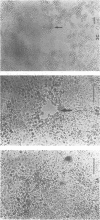Abstract
The microbiological and molecular characteristics of the rickettsiae isolated from humans with Queensland tick typhus (QTT) caused by Rickettsia australis and the recently described Flinders Island spotted fever (FISF) were compared. Clinically and serologically, the diseases are similar. Cell culture reveals differences in the plaque-forming abilities of the isolates. Characterization of the gene encoding the genus-specific 17-kDa antigen of R. australis revealed a unique nucleotide sequence unlike those of the FISF isolate and Rickettsia rickettsii. Southern blot analysis of rickettsial DNA from the isolates with a 17-kDa-antigen gene probe revealed the presence of this gene in all isolates but no difference in banding patterns. When a probe for the rRNA genes was used, clear differences in banding patterns of isolates from patients with QTT and FISF were revealed. Thus, the rickettsiae isolated from patients with FISF differ from those from patients with QTT and may represent a new rickettsial species.
Full text
PDF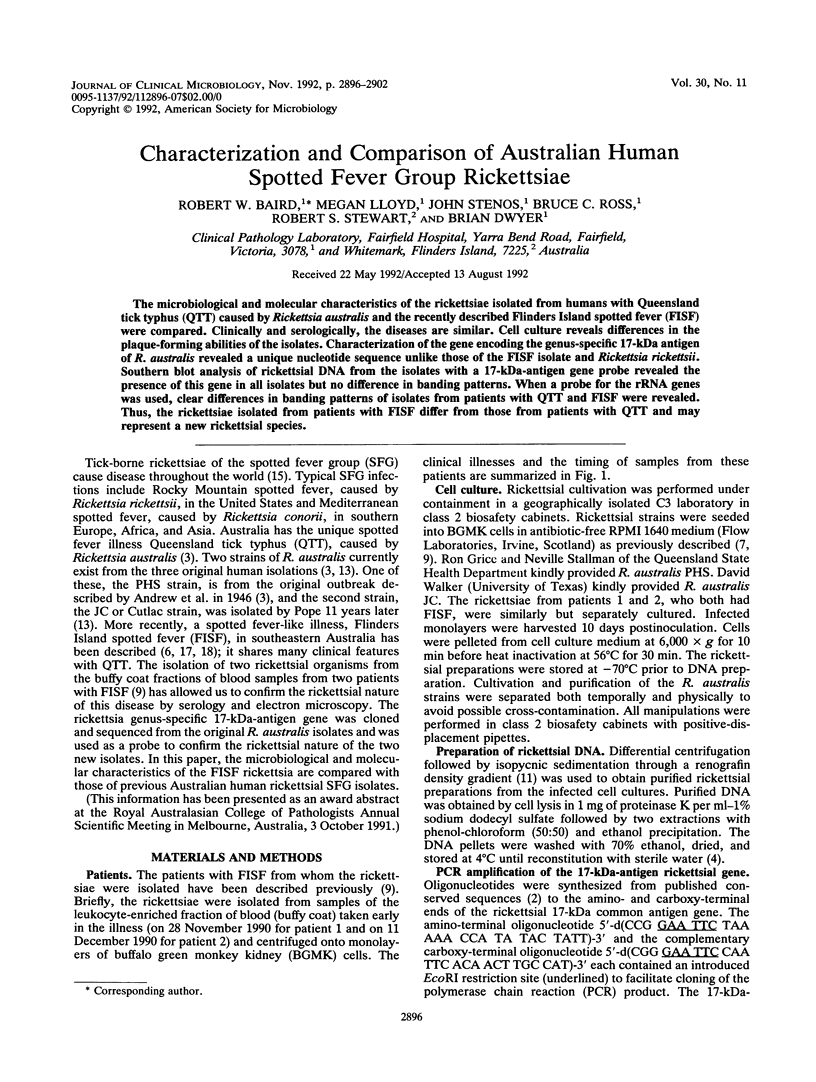

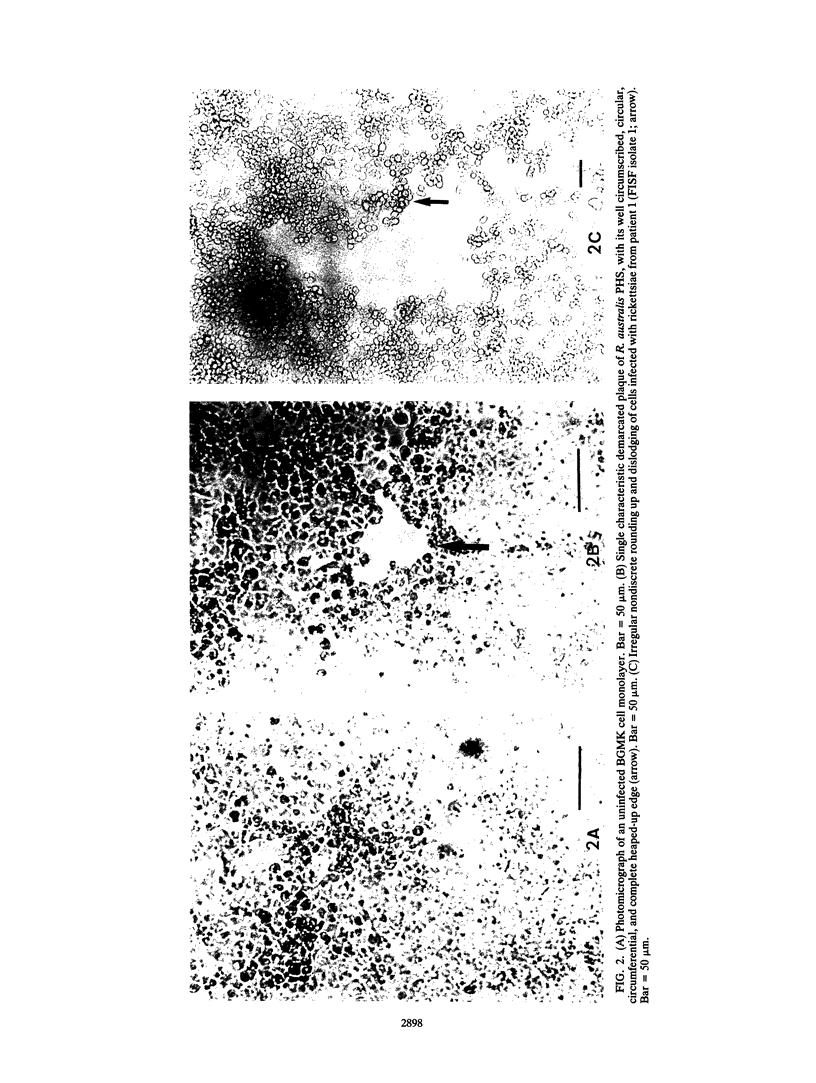
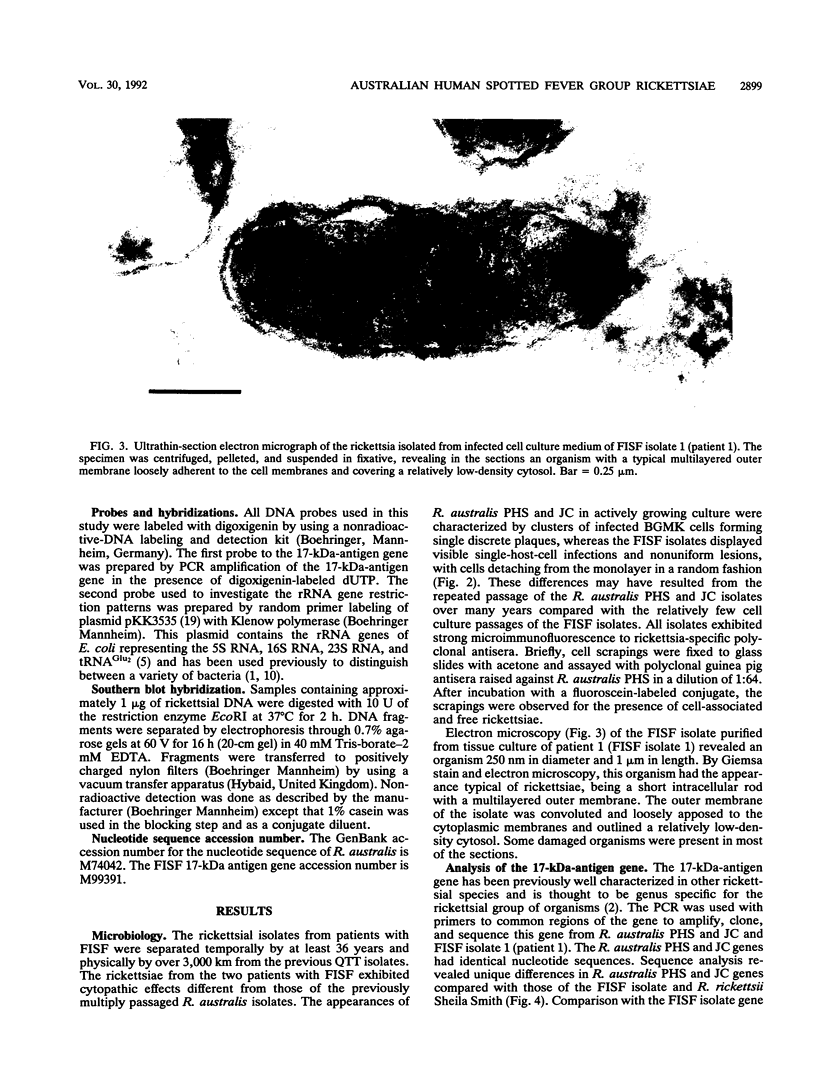
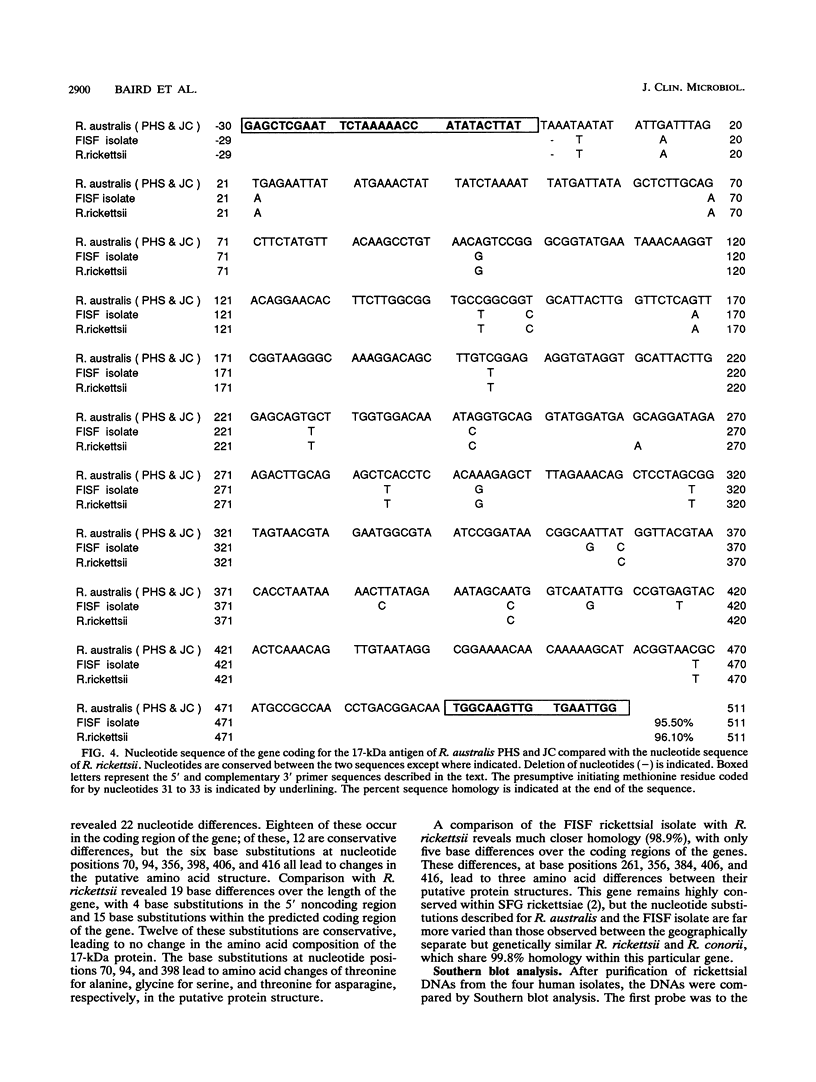
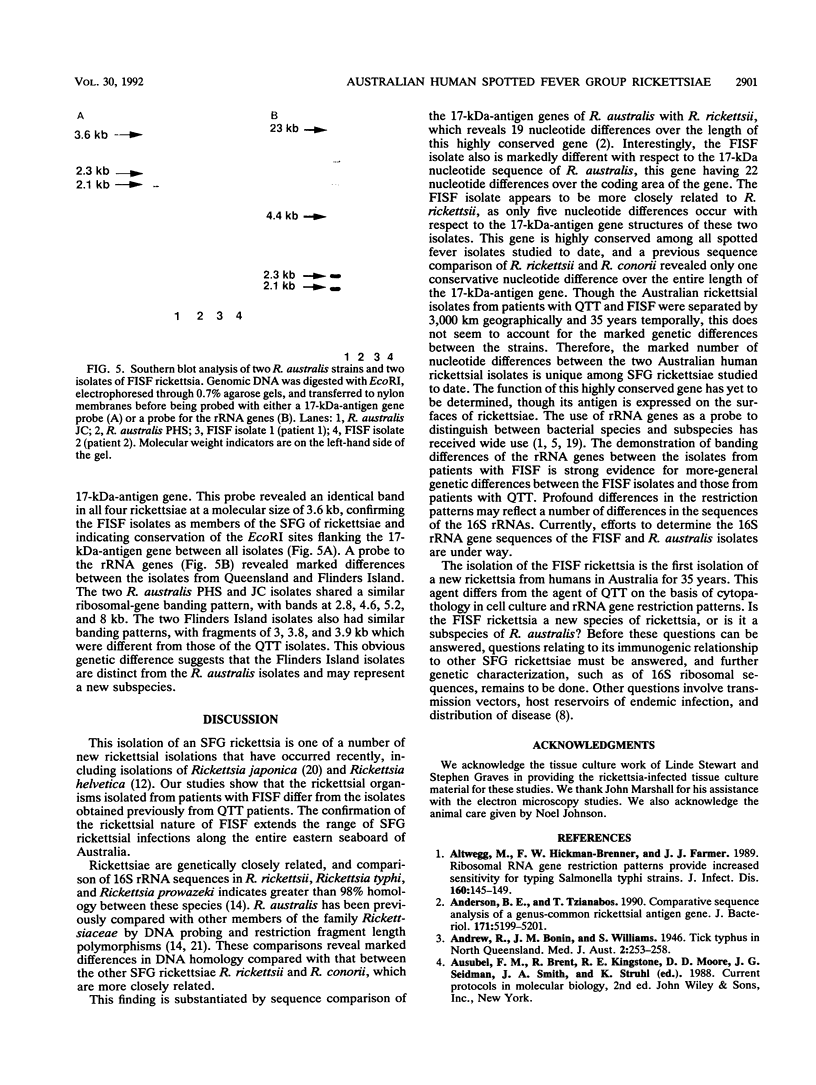
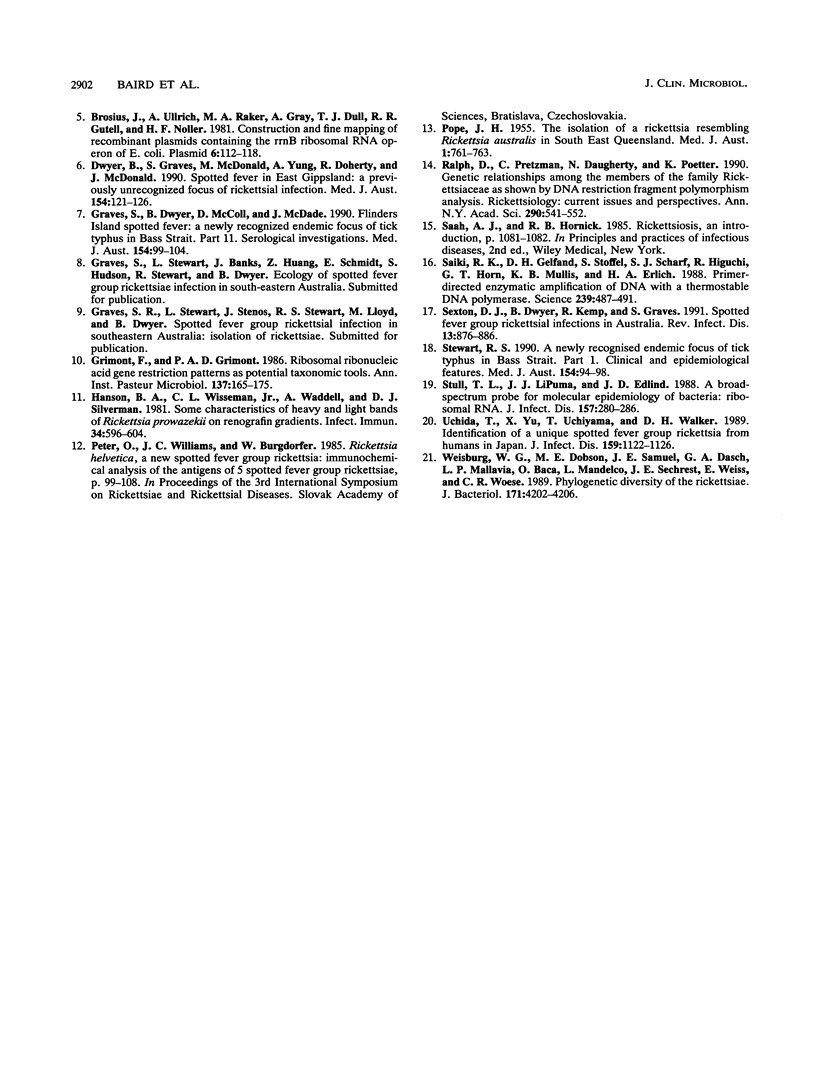
Images in this article
Selected References
These references are in PubMed. This may not be the complete list of references from this article.
- Altwegg M., Hickman-Brenner F. W., Farmer J. J., 3rd Ribosomal RNA gene restriction patterns provide increased sensitivity for typing Salmonella typhi strains. J Infect Dis. 1989 Jul;160(1):145–149. doi: 10.1093/infdis/160.1.145. [DOI] [PubMed] [Google Scholar]
- Anderson B. E., Tzianabos T. Comparative sequence analysis of a genus-common rickettsial antigen gene. J Bacteriol. 1989 Sep;171(9):5199–5201. doi: 10.1128/jb.171.9.5199-5201.1989. [DOI] [PMC free article] [PubMed] [Google Scholar]
- Brosius J., Ullrich A., Raker M. A., Gray A., Dull T. J., Gutell R. R., Noller H. F. Construction and fine mapping of recombinant plasmids containing the rrnB ribosomal RNA operon of E. coli. Plasmid. 1981 Jul;6(1):112–118. doi: 10.1016/0147-619x(81)90058-5. [DOI] [PubMed] [Google Scholar]
- Dwyer B. W., Graves S. R., McDonald M. I., Yung A. P., Doherty R. R., McDonald J. K. Spotted fever in East Gippsland, Victoria: a previously unrecognised focus of rickettsial infection. Med J Aust. 1991 Jan 21;154(2):121–125. doi: 10.5694/j.1326-5377.1991.tb120998.x. [DOI] [PubMed] [Google Scholar]
- Graves S. R., Dwyer B. W., McColl D., McDade J. E. Flinders Island spotted fever: a newly recognised endemic focus of tick typhus in Bass Strait. Part 2. Serological investigations. Med J Aust. 1991 Jan 21;154(2):99–104. doi: 10.5694/j.1326-5377.1991.tb120994.x. [DOI] [PubMed] [Google Scholar]
- Grimont F., Grimont P. A. Ribosomal ribonucleic acid gene restriction patterns as potential taxonomic tools. Ann Inst Pasteur Microbiol. 1986 Sep-Oct;137B(2):165–175. doi: 10.1016/s0769-2609(86)80105-3. [DOI] [PubMed] [Google Scholar]
- Hanson B. A., Wisseman C. L., Jr, Waddell A., Silverman D. J. Some characteristics of heavy and light bands of Rickettsia prowazekii on Renografin gradients. Infect Immun. 1981 Nov;34(2):596–604. doi: 10.1128/iai.34.2.596-604.1981. [DOI] [PMC free article] [PubMed] [Google Scholar]
- POPE J. H. The isolation of a rickettsia resembling Rickettsia australis in South East Queensland. Med J Aust. 1955 May 21;42(1 21):761–763. [PubMed] [Google Scholar]
- Ralph D., Pretzman C., Daugherty N., Poetter K. Genetic relationships among the members of the family rickettsiaceae as shown by DNA restriction fragment polymorphism analysis. Ann N Y Acad Sci. 1990;590:541–552. doi: 10.1111/j.1749-6632.1990.tb42264.x. [DOI] [PubMed] [Google Scholar]
- Saiki R. K., Gelfand D. H., Stoffel S., Scharf S. J., Higuchi R., Horn G. T., Mullis K. B., Erlich H. A. Primer-directed enzymatic amplification of DNA with a thermostable DNA polymerase. Science. 1988 Jan 29;239(4839):487–491. doi: 10.1126/science.2448875. [DOI] [PubMed] [Google Scholar]
- Sexton D. J., Dwyer B., Kemp R., Graves S. Spotted fever group rickettsial infections in Australia. Rev Infect Dis. 1991 Sep-Oct;13(5):876–886. doi: 10.1093/clinids/13.5.876. [DOI] [PubMed] [Google Scholar]
- Stewart R. S. Flinders Island spotted fever: a newly recognised endemic focus of tick typhus in Bass Strait. Part 1. Clinical and epidemiological features. Med J Aust. 1991 Jan 21;154(2):94–99. doi: 10.5694/j.1326-5377.1991.tb120993.x. [DOI] [PubMed] [Google Scholar]
- Stull T. L., LiPuma J. J., Edlind T. D. A broad-spectrum probe for molecular epidemiology of bacteria: ribosomal RNA. J Infect Dis. 1988 Feb;157(2):280–286. doi: 10.1093/infdis/157.2.280. [DOI] [PubMed] [Google Scholar]
- Uchida T., Yu X. J., Uchiyama T., Walker D. H. Identification of a unique spotted fever group rickettsia from humans in Japan. J Infect Dis. 1989 Jun;159(6):1122–1126. doi: 10.1093/infdis/159.6.1122. [DOI] [PubMed] [Google Scholar]
- Weisburg W. G., Dobson M. E., Samuel J. E., Dasch G. A., Mallavia L. P., Baca O., Mandelco L., Sechrest J. E., Weiss E., Woese C. R. Phylogenetic diversity of the Rickettsiae. J Bacteriol. 1989 Aug;171(8):4202–4206. doi: 10.1128/jb.171.8.4202-4206.1989. [DOI] [PMC free article] [PubMed] [Google Scholar]



